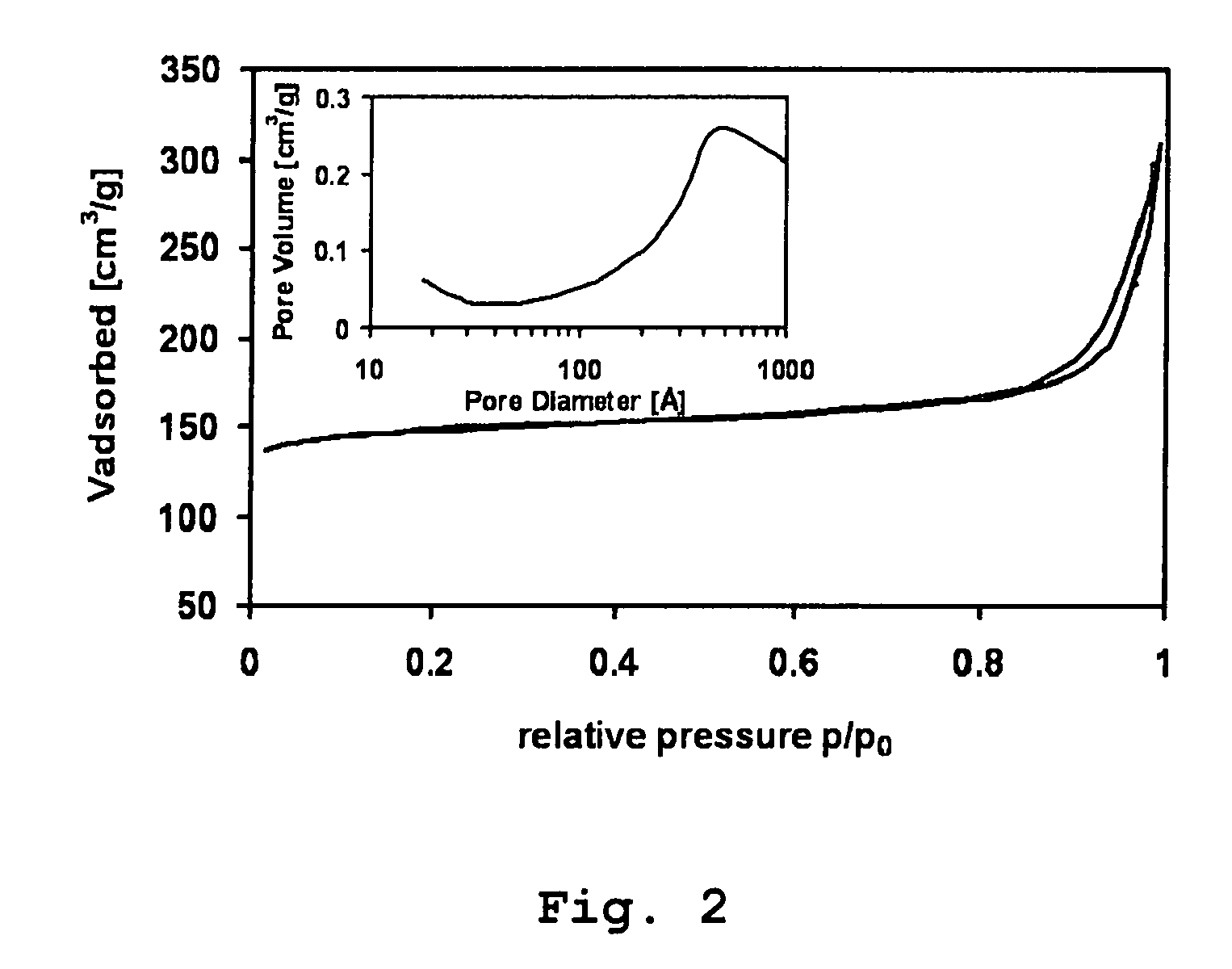Fabrication of hierarchical zeolites
a technology of hierarchical zeolites and hierarchical zeolites, which is applied in the direction of molecular-sieve silica polymorphs, silicon compounds, physical/chemical process catalysts, etc., can solve the problems of micropores imposing limitations on applicability and laborious manufacturing steps in this method
- Summary
- Abstract
- Description
- Claims
- Application Information
AI Technical Summary
Benefits of technology
Problems solved by technology
Method used
Image
Examples
example 1
[0033] Synthesis of Mesoporous ZSM-5.
[0034] SiO2 with partially decomposed carbohydrate was prepared according to the following procedure: 20 g of sucrose was dissolved in 11 g of water. 5 g of mesoporous SiO2 was impregnated with this solution to incipient wetness. The resulting material was dried overnight at room temperature and then calcined in Ar-flow in an oven at 450° C. for 15 hours.
[0035] A mesoporous Na-ZSM-5 material was prepared according to the following procedure. In a 100 ml flask, 33.83 g of 20% TPAOH, 8.50 g of H2O, 0.53 g NaOH and 0.08 g of NaAlO2 was added with stirring until a clear solution was obtained. After that the SiO2 with partially decomposed carbohydrate (silica-carbon composite) was added to this mixture. This mixture was left for 1 hour with stirring. The composition of the resulting zeolite synthesis gel was 1 Al2O3:181 SiO2:36 TPA2O:15 Na2O:1029 H2O. Then the gel was introduced into a stainless steel autoclave, heated to 180° C. and kept there for ...
example 2
[0036] Zeolite crystals from Example 1 were characterized by X-ray powder diffraction, N2 physisorption measurements, scanning electron microscopy and transmission electron microscopy after the zeolite synthesis and subsequent combustion of the organic template and the partially decomposed carbohydrates. According to these measurements, all samples contain exclusively highly crystalline MFI-structured materials. TEM of the resulting ZSM-5-type crystals is shown in FIG. 1. It is possible to see large zeolite crystals, which are recognizable as dark areas with brighter areas attributable to porosity. These are mesopores created by removal of the partially decomposed carbohydrate.
example 3
[0037] Synthesis of Mesoporous Silicalite-1.
[0038] The SiO2 with partially decomposed carbohydrates was prepared as in Example 1. The mesoporous silicalite-1 material was prepared according to the following procedure. In a 100 ml flask, 33.83 g of 20% TPAOH, 8.50 g of H2O and 0.53 g NaOH was added with stirring until a clear solution was obtained. After that the SiO2 with partially decomposed carbohydrate was added to this mixture. This mixture was left for 1 hour with stirring. The composition of the resulting synthesis gel was 181 SiO2:36 TPA2O:15 Na2O:1029 H2O. Then the gel was introduced into a stainless steel autoclave, heated to 180° C. and kept there for 72 h. Then, the autoclave was cooled to room temperature, the product was suspended in water, filtered by suction, resuspended in water and filtered again. Finally, the product was dried at 110° C. for 10 h and the organic template and the partially decomposed carbohydrates were removed by controlled combustion in air in a m...
PUM
 Login to View More
Login to View More Abstract
Description
Claims
Application Information
 Login to View More
Login to View More - R&D
- Intellectual Property
- Life Sciences
- Materials
- Tech Scout
- Unparalleled Data Quality
- Higher Quality Content
- 60% Fewer Hallucinations
Browse by: Latest US Patents, China's latest patents, Technical Efficacy Thesaurus, Application Domain, Technology Topic, Popular Technical Reports.
© 2025 PatSnap. All rights reserved.Legal|Privacy policy|Modern Slavery Act Transparency Statement|Sitemap|About US| Contact US: help@patsnap.com



